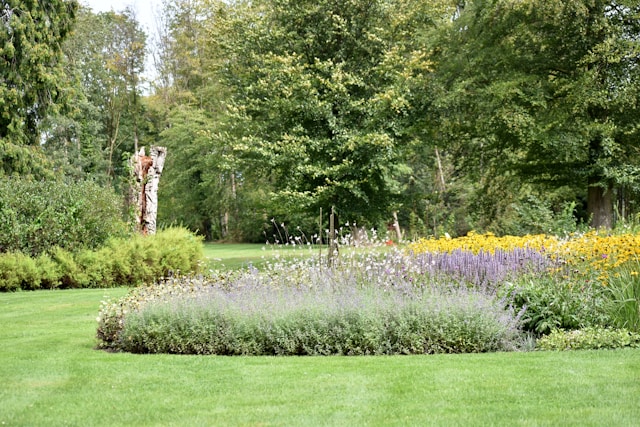- Request Free Quote
- 408-206-0832
- info@baybuildersconstruction.com
Sun, Style, and Sustainability: Landscaping Ideas That Wow This California Summer
June 16, 2025As you plan your California summer landscaping, incorporating elements that balance style with sustainability is essential. Given the region’s arid climate and the need for water conservation, opting for drought-tolerant landscaping is a smart move. This approach not only saves water but also creates visually appealing outdoor spaces.
Start by selecting California native plants, such as California Lilac, Manzanita, and lavender. These plants are naturally adapted to the local climate, requiring minimal maintenance and watering. They also support local biodiversity by providing habitats for pollinators like bees and butterflies, and they add a natural aesthetic to your yard.

Incorporating native plants into your design can be combined with other sustainable practices. Consider using xeriscaping techniques that include gravel, mulch, and low-water plants. These methods reduce water usage and create beautiful, low-maintenance areas. Additionally, smart irrigation systems with sensors and AI technology can optimize water usage, ensuring that your plants receive exactly what they need without wasting a drop.
Introduction
When it comes to landscaping in California, you’re not just designing a yard; you’re creating a sustainable oasis that thrives in the state’s arid climate. With the region’s ongoing droughts and the importance of water conservation, your landscaping choices can make a significant difference. Embracing eco-friendly landscaping is no longer just a trend, but a necessity.
To start, consider incorporating native and drought-tolerant plants into your design. Plants like California Lilac, Manzanita, and lavender are not only beautiful but also require minimal water, supporting local biodiversity and attracting pollinators.
Sustainable hardscaping is another key element. Opt for permeable paving, which reduces runoff and helps replenish groundwater. Smart irrigation systems with sensors and AI technology can optimize water usage, ensuring your yard stays lush without wasting water.
Your outdoor space should be both functional and aesthetically pleasing. Designing areas for outdoor living, such as patios and garden seats, can enhance your home’s curb appeal while providing you with a relaxing space to enjoy the California sun. By combining these elements, you can create a stunning and eco-friendly landscape that not only looks great but also supports the local ecosystem.
1. Embracing Drought-Tolerant Landscaping
Embracing drought-tolerant landscaping in California is a practical and aesthetically pleasing way to transform your outdoor space. This approach not only saves resources but also supports biodiversity and natural pollinators. You can start by replacing traditional lawns with drought-resistant plants, such as California native species, which are adapted to the region’s arid climate. These plants require less water and maintenance, making them ideal for water-conscious homeowners.
When selecting plants, consider options like Lantana, which can serve as both an accent shrub and a trailing or mounding groundcover. It comes in a variety of colors, adding vibrancy to your landscape without the need for extensive watering. Incorporating trees and hedges that are drought-tolerant can also provide shade, focal points, and privacy while keeping water usage minimal.
Creating pollinator-friendly gardens is another key aspect of drought-tolerant landscaping. By using native plants, you attract local bees, butterflies, and other pollinators, enhancing the ecosystem of your garden. Adding features like rain gardens and mulch can further optimize water efficiency and create a lush, inviting environment. This holistic approach guarantees your outdoor space is both beautiful and sustainable, making it perfect for a California summer.
2. Showcasing California Native Plants
To further enhance your drought-tolerant landscaping, consider showcasing California native plants, which are naturally adapted to the state’s diverse climates and soil types. These plants, such as the vibrant California poppy, are ideal for xeriscaping, a type of landscaping that emphasizes water efficiency.
Native plants offer numerous benefits, including significant water savings. Once established, they use up to 80% less water than conventional gardens, making them a vital component in water conservation efforts.
In addition to their water efficiency, native plants require minimal maintenance. They are already adapted to local soils and insect pests, which means you’ll need fewer fertilizers and pesticides. This not only saves you money but also reduces the environmental impact of your garden.
Native plants also support local ecosystems by providing habitat for native birds, butterflies, and pollinators. This integration with the natural environment enhances the biodiversity of your garden and creates a beautiful, thriving landscape that connects you to the natural beauty of California.
3. Incorporating Sustainable Hardscaping
How can you enhance your California landscape while minimizing its environmental footprint? Incorporating sustainable hardscaping is an essential step in creating an eco-friendly and visually appealing outdoor space. When designing your landscape, consider using materials that not only look good but also support environmental sustainability.
One of the key elements in sustainable hardscaping is the use of permeable materials. Permeable pavers, for instance, allow rainwater to percolate through the soil, reducing runoff and the need for extensive drainage systems. This approach helps maintain soil health, reduces the burden on local water treatment facilities, and minimizes the amount of green waste sent to landfills.
Additionally, materials like decomposed granite and permeable pavers can be integrated seamlessly into your design. These materials age beautifully, require minimal upkeep, and can be sourced locally to reduce the carbon footprint of your project. By choosing these sustainable options, you can create functional and beautiful outdoor living areas that complement your home’s existing aesthetic while supporting the local environment. This approach guarantees your landscape is not just stylish but also environmentally responsible, making it perfect for eco-conscious homeowners in California.
4. Designing Inviting Outdoor Living Spaces
After incorporating sustainable hardscaping into your California landscape, the next step is to design inviting outdoor living spaces that blend seamlessly with your eco-friendly hardscaping. These areas should be functional, comfortable, and reflective of the California lifestyle that values indoor-outdoor living.
To create an inviting outdoor living space, consider using outdoor-rated furniture such as love seats, sofas, and side tables. These pieces should be durable and stylish, able to withstand the elements while maintaining a luxurious feel. Add throw rugs, pillows, and small decor items to personalize the space and make it feel like an extension of your home.
Large windows and sliding glass doors can blur the lines between your indoor room and the outdoors, maximizing natural light, fresh air, and expansive views. This design approach enhances the sense of freedom and tranquility, making the space feel light and airy.
Ensure your outdoor living spaces are equipped with efficient irrigation systems to support your drought-tolerant landscaping. This not only saves water but also reduces maintenance, aligning with California’s water conservation needs. By integrating these elements, you can create an outdoor living space that is both stylish and sustainable, perfect for enjoying the California summer.
5. Creating Pollinator-Friendly Gardens
Creating a pollinator-friendly garden in your California yard is a great way to support local ecosystems and add beauty to your outdoor space. This type of garden offers numerous benefits, including providing a constant source of nectar and pollen for native bees, butterflies, and other pollinators. By incorporating native plants, you can guarantee a diverse and thriving pollinator population.
Choose plants that bloom at different times of the year to provide a year-round food source. For example, manzanitas (Arctostaphylos sp.) are excellent for early-season blooms, while showy penstemon (Penstemon spectabilis) and San Diego pitcher sage (Lepechinia fragrans) offer vibrant flowers in the spring and summer.
California sagebrush (Artemisia californica) is another valuable addition, as it attracts a variety of pollinators and is highly drought-tolerant. Other native plants like Dudleya, Eriogonum, and Oenothera are also great options to include in your pollinator garden.
Conclusion
By incorporating native plants and designing your garden with sustainability in mind, you’re not only enhancing your outdoor space but also contributing to the health of local ecosystems. Drought-tolerant landscaping is a key component of this approach, as it greatly reduces water consumption, an essential aspect in California’s arid climate. This method not only lowers your water bills but also helps in conserving this precious resource, making it a cost-effective and environmentally responsible choice.
In addition to drought-tolerant plants, sustainable hardscaping plays an important role in your landscaping strategy. This involves using materials and designs that minimize water runoff and support the natural drainage of the area. For example, installing bioswales can improve water quality, reduce localized flooding, and recharge groundwater, adding multiple benefits to your sustainable landscape.
